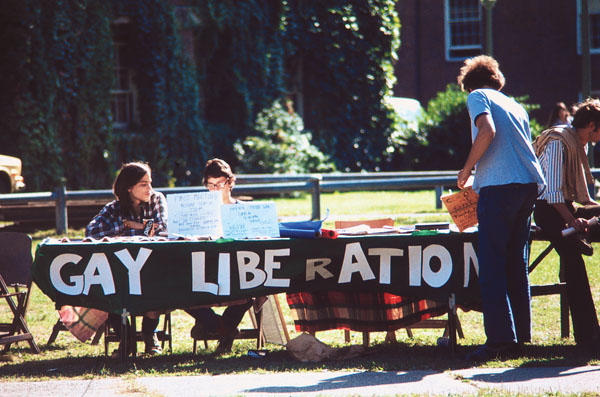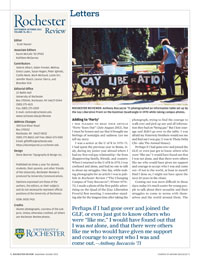Letters
 ROCHESTER REVIEWER: Anthony Boccaccio ’71 photographed an information table set up by the Gay Liberation Front on the Eastman Quadrangle in 1970 while taking campus photos. (Photo: Courtesy of anthony Boccaccio ’71)
ROCHESTER REVIEWER: Anthony Boccaccio ’71 photographed an information table set up by the Gay Liberation Front on the Eastman Quadrangle in 1970 while taking campus photos. (Photo: Courtesy of anthony Boccaccio ’71)Adding to ‘Forty’
I was pleased to read your article “Forty Years Out” (July-August 2013), but I must be honest and say that it brought me feelings of nostalgia and sadness. Let me tell my story:
I was a senior at the U of R in 1970–71. I had spent the previous year in Rome, Italy, during my junior year abroad where I had my first real gay relationship—far from disapproving family, friends, and country. When I returned to the U of R in 1970, I was confused and alone, and had no one to talk to about my struggles. One day, while making photographs for an article I was to publish in Rochester Review (“The Changing Campus of Tony Boccaccio”; Winter 1970–71), I made a photo of the first public advertising on the Quad of the [Gay Liberation Front’s] first meeting. I remember standing afar for the longest time after taking the photograph, trying to find the courage to walk over and pick up any and all information they had on “being gay.” But I lost courage and didn’t go over to the table. I was afraid my fraternity brothers would see me and find out I was gay. (I was in Theta Delta Chi—aka The Animal House).
Perhaps if I had gone over and joined the GLF, or even just got to know others who were “like me,” I would have found out that I was not alone, and that there were others like me who would have given me support and courage to accept who I was and come out—if not to the world, at least to myself. Had I done so, I might not have spent the next 20 years in the closet.
Coming out was more difficult in those days; today it’s much easier for young people to talk about their sexuality and their struggles to come to terms with themselves and the world around them. The best I could do at that time was to make photographs that expressed my struggles and confusion. This led to a photo story idea for Review that John Braund ’53, ’61W (Mas) of the alumni office and Mim Rock (may she rest in peace!) of academic advising encouraged me to do and fully supported.
The photo of the first GLF public exposure is a moment frozen in time; a moment that remained frozen for me for 20 years. I do not know who the people are in the photo; perhaps you do.
I also want to share a short video I made recently that tells the story of my senior photography project, and how 40 years later, I discovered that these photographs foretold the consequences of not going to the first meeting of the GLF, and my subsequent 20 years in the closet. You can see the video at www.youtube.com/watch?v=_16ZLM0G1JA.
Thank you for publishing this article; it brings me sad memories but also offers a deeper knowledge that what was started at the U of R by two very courageous young men has had its impact on generations.
Anthony Boccaccio ’71
Spokane, Wash.
Civil War Visit
I really enjoyed the May-June issue. Lots of good, substantive material, but I especially enjoyed reading the two Civil War articles. The two-page graphic on Gettysburg was top-notch—brought me back to my visit to the battlefield some years ago; amazing so many alums were present at crucial points in the battle.
And Steven Hahn’s “The Forge of a New Nation” was as good as anything I have read on the subject, including the New York Times’ wonderful Disunion blog.
Keep up the good aspirational work—it’s appreciated.
Randy Whitestone ’83
New York City
Questions on College Town
My initial reaction to your story in the March–April edition about the soon-to-be-built College Town was “about time!” I’m glad to see the leadership of UR finally recognizing the need for the campus to be more connected to the larger community. Unfortunately, I was disappointed when I saw the actual design: it is essentially a suburban shopping development, not a true college town.
Given the attention that livability and sustainability of urban areas have been receiving in the last decade, how can an institution such as UR not show better leadership on these issues? Why is this project built around the car rather than walking and bicycling (after all, how many students actually have cars at UR)? And 1,560 car parking spaces? There is little else that drives unsustainable, autocentric development as much as cheap (if not free) parking, so this type of design is just exacerbating anachronistic urban development.
Where is the bicycle parking? And bike lanes? Instead of an ugly car parking lot in the middle of the complex (isn’t a huge car parking garage enough?), why not some lush greenery scattered with tables and benches for students and others in the community to sit, relax, and study? I think UR can do much better than just another car-centric, suburban development, and so I found myself again disappointed to realize how behind the times the UR seems when it comes to sustainability. When will my alma mater realize that one of the most defining issues of the current, and certainly future, generations is sustainability and “get with the program”?
Jonathan Dirrenberger ’97, ’98 (MS)
San Francisco
Department of Corrections
The caption for the photo (“Ferris Wheelers’ Day Off”) on the back cover of the July-August issue should have attributed the planning and programming for Dandelion Day to the Campus Activities Board along with the student group UR Concerts and University staff. While the Students’ Association provides some funding for the day, the organization is not responsible for the day’s programming.
Review welcomes letters and will print them as space permits. Letters may be edited for brevity and clarity. Unsigned letters cannot be used. Send letters to Rochester Review, 22 Wallis Hall, P.O. Box 270044, University of Rochester, Rochester, NY 14627-0044; rochrev@rochester.edu.

